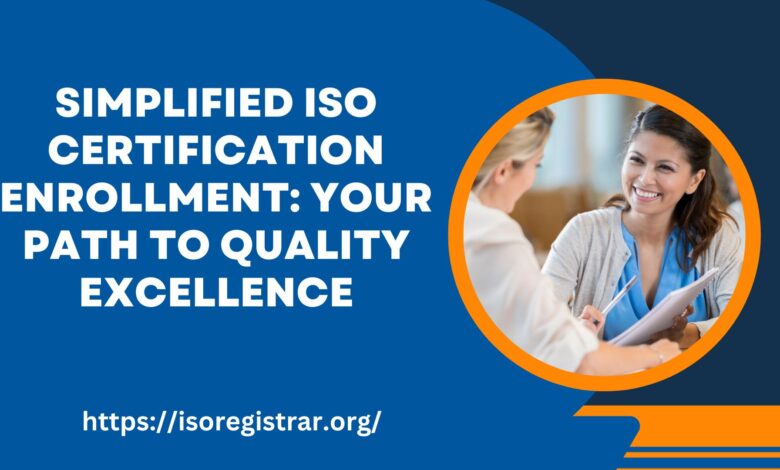Simplified ISO Certification Enrollment: Your Path to Quality Excellence

Introduction
In today’s competitive global business landscape, organizations strive to maintain high standards of quality and operational efficiency. Achieving and demonstrating these standards often requires certification from the International Organization for Standardization (ISO). ISO certification not only enhances an organization’s credibility but also opens doors to new business opportunities, fosters customer trust, and ensures continuous improvement. However, the process of enrolling for ISO certification can seem daunting to many. In this comprehensive article, we will guide you through the simplified ISO certification enrollment process, making it accessible and achievable for organizations of all sizes and industries.
Understanding ISO Certification
Before we delve into the enrollment process, it’s essential to understand the basics of ISO certification. The International Organization for Standardization (ISO) is an independent, non-governmental international organization that develops and publishes voluntary international standards for various industries. ISO standards cover a wide range of topics, including quality management, environmental management, information security, and more.
ISO certification is a third-party validation process that confirms an organization’s compliance with specific ISO standards. Achieving ISO certification involves a series of steps, including gap analysis, process improvement, documentation, and external audits. Once certified, organizations can proudly display their ISO certification marks, indicating their commitment to quality and excellence.
Simplified ISO Certification Enrollment Process
Identify Your ISO Standard:
The first step in the ISO certification enrollment process is to identify the specific ISO standard that best aligns with your organization’s goals, industry, and customer requirements. Common standards include ISO 9001 (Quality Management), ISO 14001 (Environmental Management), ISO 27001 (Information Security Management), and ISO 45001 (Occupational Health and Safety).
Appoint an ISO Champion:
Designate a dedicated team or individual within your organization to serve as the ISO champion. This person will be responsible for overseeing the certification process, coordinating with external certification bodies, and ensuring that all necessary steps are completed.
Conduct a Gap Analysis:
To assess your organization’s current state of compliance with the chosen ISO standard, conduct a thorough gap analysis. This involves identifying areas where your organization falls short of meeting the standard’s requirements.
Develop an Implementation Plan:
Based on the gap analysis results, create a comprehensive implementation plan. This plan should outline the specific actions, timelines, and responsible individuals or teams for each aspect of the ISO standard.
Employee Training and Awareness:
Ensure that your employees are aware of the ISO certification process and its importance. Training and raising awareness among staff members can significantly contribute to successful implementation.
Documentation:
One of the core components of ISO certification is the creation of documented processes and procedures that align with the chosen standard. This documentation serves as evidence of compliance during the certification audit.
Internal Audits:
Conduct internal audits to verify that your organization’s processes align with the ISO standard. These audits help identify any remaining gaps or areas that require improvement.
Select a Certification Body:
Choose an accredited certification body that specializes in the ISO standard you are pursuing. The certification body will conduct an external audit to evaluate your organization’s compliance.
External Audit:
The certification body will schedule and perform an external audit, typically in two stages: a readiness assessment and a final certification audit. During these audits, the certification body will evaluate your organization’s processes, documentation, and overall compliance with the ISO standard.
Certification:
If your organization successfully passes the external audits, the certification body will issue an ISO certificate. This certificate is a formal acknowledgment of your organization’s compliance with the ISO standard.
Continuous Improvement:
ISO certification is not a one-time achievement but an ongoing commitment to quality and excellence. Implement continuous improvement processes to ensure that your organization maintains and enhances its compliance with the ISO standard.
See Also: ISO 9001 Certificate
Conclusion
Obtaining ISO certification is a significant milestone for any organization, demonstrating a commitment to quality, efficiency, and customer satisfaction. While the process may seem complex, a systematic and simplified approach can make ISO certification enrollment accessible and achievable for organizations of all sizes and industries.
By following the steps outlined in this article, your organization can embark on a journey toward ISO certification, reaping the numerous benefits it offers. From improved processes to enhanced credibility in the market, ISO certification is a valuable investment that paves the way for long-term success and quality excellence. So, start your ISO certification journey today and position your organization as a leader in its industry.





